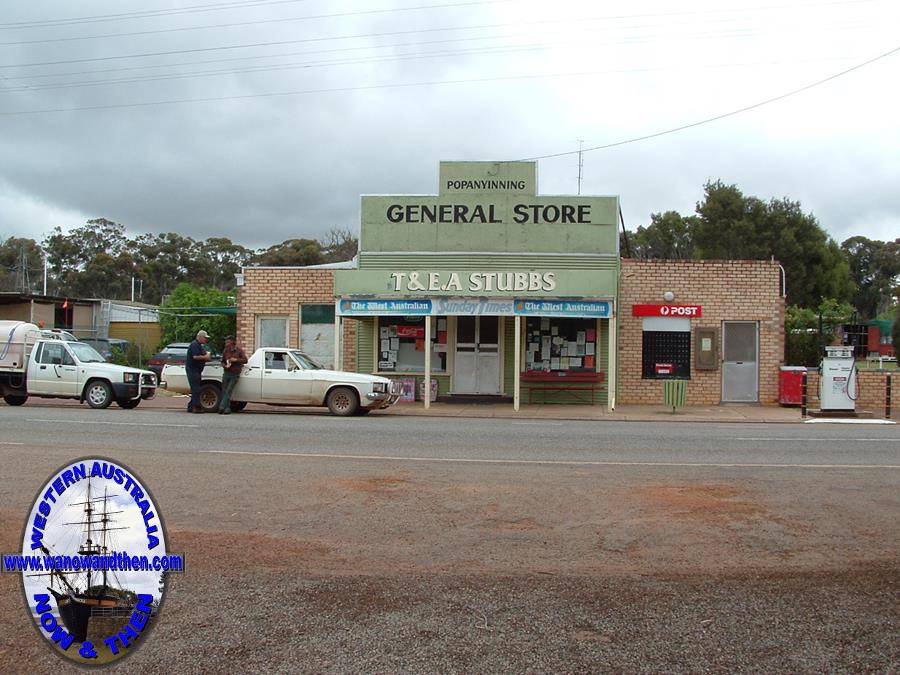DESCRIPTION
Popanyinning is situated 19 Kms north of Cuballing and south of the larger town of Pingelly.
The town is located near the Hotham River.
One of the oldest of small town traditions still survives in Popo with regular dances being held (usually on the third Saturday of the month) which are well attended by people from far and wide.
There is a rest stop and a general store but not a great deal else in town.
There are many different types of orchid found in the area during late winter.
HISTORY
Pop-an-yinning was originally named 'Popaning' (it was also recorded as Papaning and Poopanyinning) and is said by one source to mean 'waterhole' in the Aboriginal language, while another source
quotes the meaning as 'Place where battles are remembered.'
The name came about from a large waterhole that was situated just outside of the town. The waterhole was used by Aborigines and wild brumbies from around the district. Years later the name was changed
to Popanyinning, but no-one is really quite sure why.
The birth of the township of Popanyinning can be attributed to both the construction of the Great Southern Railway and the desire of pioneers to settle within the perimeter of the town site, being approximately
3.4 miles north and south and 1.4 miles east and west. Records show that the first pioneers arrived in 1893, and in 1898 railway construction workers and their families arrived.
By 1906 there were 72 families registered within the Popanyinning district. The town was basically built for agricultural conveniences so that surrounding settlers could come and buy their monthly supplies
from the local shops and for the use of the railway facilities. Once there were several shops in the main street, such as a Blacksmith's, General Store and Post Office, Mixed Goods Store and a Bakery.
On 2 April 1906 the Popanyinning Hotel was officially opened. It was very successful for many years, until 9 July 1978 when it sadly burnt down. The Hotel has never been replaced. Residents held a
wake for the hotel on the 10th anniversary of its demise.
The town hall was constructed in 1905 and sadly during the construction one of the builders died after a fall from the roof. The nearest medical assistance at the time was in Beverley, had it been closer
he may well have survived. The hall was the target of an arson attack in 1978, but John Tate raised the alarm and despite some damage to the stage, the building was saved.
In 1908 a church for al denominations was constructed in the town and initially it was an important social centre. Its use declined in the late 1940s and it was last known to have been used for services in
1968. Sadly the building no longer exists.
In 1975 the residents had to defend the (by then) disused railway station against demolition. Half the platform had already been bulldozed by the time residents managed to get work stopped. By 1990
the station had been restored but is still missing half of its original platform. (Having looked at the station ourselves we were hard pressed to see where the demolition had taken place but apparently the
platform was once the longest on the Great Southern line.)
TALL TALES AND TRUE
Dying to be together.
In 1942 Mrs. Lindsay suddenly passed away from a heart attack. Her husband, working in Bindoon died the same day of the same cause. The two hearses, bringing the departed to
Pingelly to be identified, arrived outside the police station at exactly the same time.
Sawn off shop.
When Mr. Spragg built the first store in town (1904) he sited it in an area he thought may be flood prone so it was built on stilts. When the railway came through the surveyors informed him that he had
to move the shop which he did, relocating some short distance west. As there had been no floods he built the new shop with firm footings with the idea that it would be there permanently. The surveyors,
however, had other ideas. Some time later when the main road was being put through the surveyors again informed Mr. Spragg that his shop was 3 feet too far forward. Fed up with having to continually
shift the store, Mr. Spragg simply got a saw and cut off the front 3 feet of the building.
VIDEO
PROBLEM PLAYING THESE ON FIREFOX?
Turn off Enhanced Tracking Protection
Click the shield icon left of the URL near the top left
Slide Advanced Tracking Protection to OFF
Nothing Available.
OTHER INFORMATION
ATTRACTIONS
BUILDINGS OF NOTE
Railway station.
ELECTORAL ZONES
State : Wagin
Federal : O'Connor
OTHER INFO.
Postcode : 6309
Local Government : Town of Cuballing
PHOTOS
Click on a thumbnail to see full sized picture.
Please note that using the https url will cause the photos not to show. To show photos use the standard http url.










